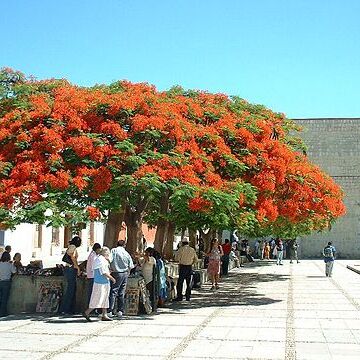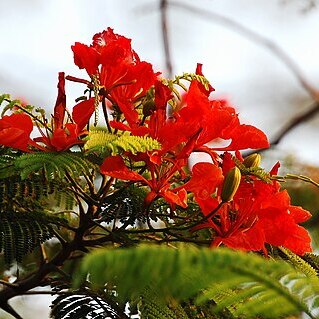Unarmed trees. Leaves bipinnate; stipules small, subulate and caducous or leafy and forked basally into 2 pinnate divisions; leaflets opposite, numerous. Inflorescences of short, axillary, corymbose racemes aggregated near ends of branchlets. Bracts small, inconspicuous, falling while the flower buds are still young, or persistent. Flowers large, bisexual. Sepals 5, valvate. Petals 5, conspicuously clawed, obovate to transversely elliptic or reniform, equal or subequal except that the upper posticous one is somewhat different from the rest in shape and colour. Stamens 10, all fertile; filaments pubescent or tomentose below; anthers dorsifixed. Ovary shortly stipitate; style not or only somewhat enlarged near apex into a transverse, ciliate, but not peltate, stigma. Pod linear-oblong, flattened, many-seeded, dehiscing longitudinally into 2 woody or coriaceous valves. Seeds transverse, hard, flattened and oblong-elliptic or oblong-subcylindrical.
Moderate, unarmed trees. Leaves twice-pinnate, the pinnae several pairs and opposite on the rachis, each pinna with numerous opposite leaflets; petiole mod-erately short, expanded basally, eglandular; rachis elongate, flattened above, egland-ular; stipules caducous; ultimate leaflets small, short-petiolulate. Inflorescence terminal or axillary, subcorymbose (of 1 to several racemes). Flowers showy; calyx-tube short; calyx-lobes subequal, much exceeding the tube, valvate; petals separate and spreading, long-clawed; stamens 10, subdeclinate, free, the anthers versatile and longitudinally dehiscent; ovary scarcely stipitate; style slender; stigma truncate. Legume thick-flattened, dehiscent, the valves ligneous; seeds transverse.
Trees unarmed. Leaves bipinnate. Leaflets numerous, opposite. Inflorescences axillary, racemose, aggregated near the ends of the branchlets; bracts small, inconspicuous, deciduous or persistent. Flowers large, showy, bisexual. Sepals 5, valvate. Petals 5, obovate, transversely elliptic or reniform, conspicuously clawed. Stamens 10, fertile, exserted; filaments pubescent or tomentose below; anthers dorsifixed, longitudinally dehiscing. Ovary shortly stipitate, pubescent to glabrous, many-ovuled; style about equalling the length of stamens. Pods linear-oblong, flattened, dehiscing into 2 woody or leathery valves, many-seeded. Seeds transverse, hard, oblong-subcylindrical to oblong-elliptic.
Trees, unarmed. Leaves large, abruptly bipinnate, stipulate; pinnae many pairs; leaflets numerous, small. Inflorescences corymbose racemes, terminal. Flowers bisexual, white, orange, or red, large, showy. Bracts caducous, small. Receptacle discoid or turbinate. Sepals 5, obovate, subequal, valvate. Petals 5, alternating with sepals, orbicular, margin crispate, clawed. Stamens 10, free, declined. Ovary sessile; ovules numerous; style filiform; stigma truncate. Legume pendulous, compressed, strap-shaped, 2-valved; valves thickly woody, hard. Seeds transverse, oblong.
Leaves bipinnate with 2–23 pairs of leaflets, without specialised glands on petiole and rachis; leaflets opposite in (4)6–32 pairs, eglandular; stipules small, subulate and caducous or pinnately compound with up to 6 pairs of pinnae and often persistent.
Flowers with a distinct hypanthium, the lower part of which is narrower and simulates the pedicel but is clearly demarcated from it by a joint, the upper part being expanded into a shallowly concave disc or a conspicuous cup, persisting into fruiting.
Ovary ± sessile or shortly stipitate, glabrous to sericeous-tomentose, with numerous ovules, tapered above into a long style approximately equalling the stamens and somewhat broadened at the apex to form a flattish, ciliate stigma.
Pods 13–70 cm long, linear-oblong to linear, flattened, coriaceous or woody, dehiscing down both sides; seeds numerous, transversely elongate in the pod, compressed or subcylindrical, with endosperm.
Petals 5, subequal except that the upper one usually differs slightly in size, shape and colour, all with a long claw, the broad part suborbicular to reniform.
Racemes axillary, subcorymbose, with up to c.20 fairly large flowers, often in groups and so appearing compound; bracts ± ovate, caducous.
Stamens 10, all fertile, often conspicuously exserted, eglandular; anthers dorsifixed, dehiscing by longitudinal slits.
Sepals 5, valvate, somewhat leathery.
Unarmed trees.


